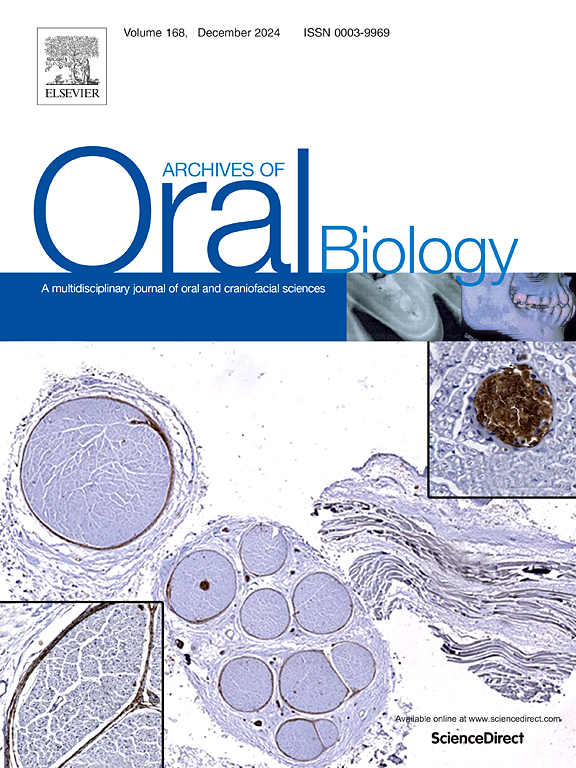In vitro development of a radicular cyst: A morphological investigation of a spheroid cyst-like model associated with fibroblasts
IF 2.2
4区 医学
Q2 DENTISTRY, ORAL SURGERY & MEDICINE
引用次数: 0
Abstract
Objective
The aim of this study was to improve the in vitro model of tooth radicular cyst previously developed by incorporating stromal components and to describe histologic analysis.
Design
A radicular cystogenesis-like 3D model was generated using HaCaT cells (1 × 105) to developing spheroid. After 24 h, spheroids were embedded in non-polymerized collagen in combination with 1 × 105 fibroblast cells (HaCaT + 1 × 105 hFIB) to mimic stromal microenvironment. Micrographs were taken to evaluate the cystic stability and dispersion area, while histological hematoxylin/eosin staining was used to measure the ratio of epithelial lining area. Analysis was conducted on days 1, 3, and 7 using ImageJ software. Statistical analyses were performed using GraphPad Prism 5 software.
Results
The model, with fibroblasts included, preserved the cystic structure and allowed cyst growth, with an increase in both the area and dispersion of the cystic structure throughout the experimental period (p < 0.05). Histological analysis of the cyst model revealed morphological similarities with in vivo tooth radicular cyst biopsies, showing a cystic cavity lined by an epithelial layer, surrounded by collagen and fibroblasts. Additionally, the cavity area increased while the limiting epithelial area decreased. The highest epithelial area-to-total area ratio was observed in day 1 spheroids, while the lowest was found on day 7 (p < 0.05).
Conclusion
The incorporation of fibroblasts improved the in vitro cystogenesis model, since it did not interfere with the model’s development and more closely mimicked the in vivo microenvironment.
根状囊肿的体外发育:与成纤维细胞相关的球状囊肿样模型的形态学研究
目的采用间质成分对牙根性囊肿体外模型进行改进,并进行组织学分析。采用HaCaT细胞(1 × 105)形成根状囊泡样三维模型。24 h后,球体与1 × 105成纤维细胞(HaCaT + 1 × 105 hFIB)一起包埋在非聚合胶原中,模拟基质微环境。显微镜观察囊性稳定性和弥散面积,组织苏木精/伊红染色测定上皮衬里面积的比值。在第1、3、7天使用ImageJ软件进行分析。采用GraphPad Prism 5软件进行统计分析。结果含成纤维细胞的模型保留了囊性结构并允许囊肿生长,在整个实验期间囊性结构的面积和弥散度均有所增加(p <; 0.05)。该囊肿模型的组织学分析显示其形态与活体牙根性囊肿活检相似,显示出由上皮层内衬的囊腔,被胶原和成纤维细胞包围。此外,空腔面积增加,而限制上皮面积减少。上皮面积与总面积之比在第1天最高,第7天最低(p <; 0.05)。结论成纤维细胞的掺入对体外膀胱形成模型无干扰,更接近体内微环境,改善了体外膀胱形成模型。
本文章由计算机程序翻译,如有差异,请以英文原文为准。
求助全文
约1分钟内获得全文
求助全文
来源期刊

Archives of oral biology
医学-牙科与口腔外科
CiteScore
5.10
自引率
3.30%
发文量
177
审稿时长
26 days
期刊介绍:
Archives of Oral Biology is an international journal which aims to publish papers of the highest scientific quality in the oral and craniofacial sciences. The journal is particularly interested in research which advances knowledge in the mechanisms of craniofacial development and disease, including:
Cell and molecular biology
Molecular genetics
Immunology
Pathogenesis
Cellular microbiology
Embryology
Syndromology
Forensic dentistry
 求助内容:
求助内容: 应助结果提醒方式:
应助结果提醒方式:


